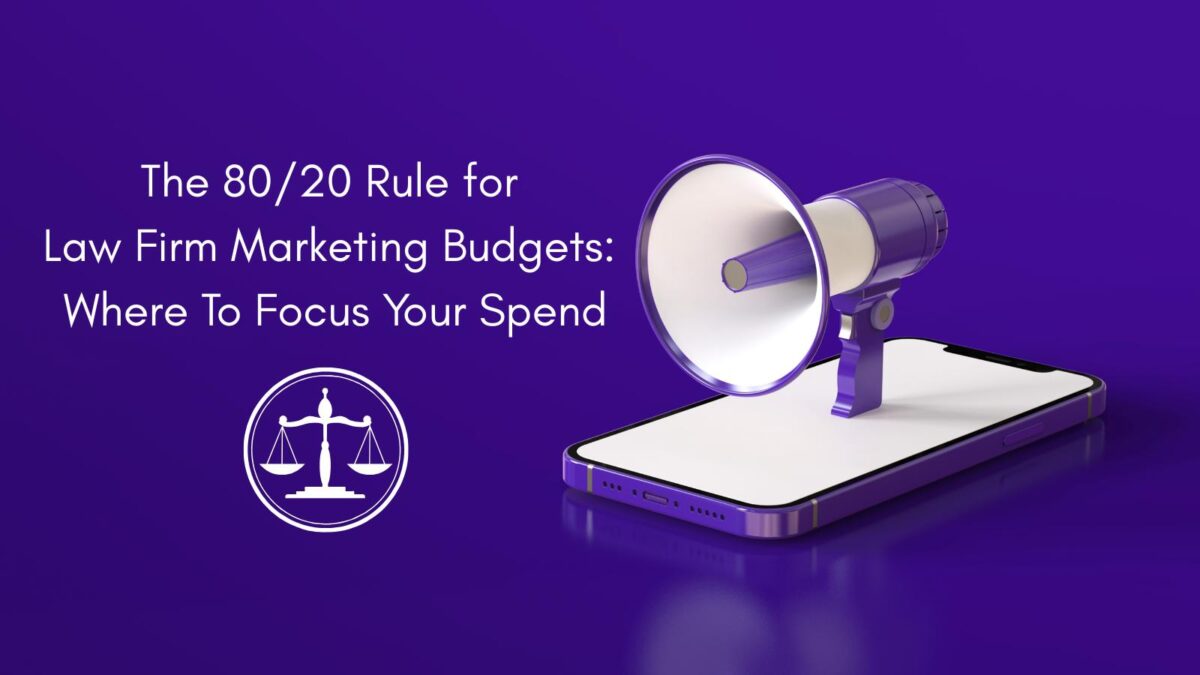When it comes to marketing your law firm, spending wisely can make or break your growth. The 80/20 rule, also known as the Pareto Principle, helps you identify where to focus your time and money.
If you’re managing law firm marketing budgets, understanding this rule can maximize your return on investment.
Table of Contents
The 80/20 Rule in Legal Marketing
The 80/20 rule suggests that 80% of your results come from 20% of your efforts. In marketing terms, that means a small portion of your strategies are likely driving most of your leads, clients, or revenue.
If you’ve been spreading your budget across multiple channels without seeing results, this principle helps you concentrate on what works.

1. Law Firm Marketing: Identify Your Top-Performing Channels
First, review past campaigns or analytics to determine which channels bring in the most qualified leads. Maybe your Google Ads campaigns drive 70% of your calls, while Facebook ads produce minimal traction.
Instead of splitting your budget evenly across platforms, invest more heavily in what converts. When law firm marketing budgets are tight, this shift can immediately increase effectiveness.
2. Optimize for Your Ideal Law Firm Clients
You’re not just trying to attract traffic, you’re aiming to bring in clients who are a good fit for your legal services. If you run a personal injury firm, and most of your high-value cases come from motor vehicle accident leads via organic search, prioritize SEO and content marketing in that space.
Apply the 80/20 rule by doubling down on client types and services that bring in the most revenue with the least effort.
3. Reduce Spend on Low-ROI Activities for Law Firm Marketing
Are you spending thousands on social media without seeing real leads? Or paying for legal directories that barely generate calls?
The 80/20 rule gives you permission to cut those out. While it’s tempting to be everywhere, your budget will stretch further if you cut out channels that don’t convert and redirect those funds to your top 20% activities.
4. Refine Your Messaging Based on Data
Marketing isn’t just about where you show up, it’s about what you say. Look at which ads or content pieces generate the most leads or longest time spent on your website.
You might discover that 80% of your engagement comes from 20% of your messaging. Once you pinpoint what resonates, replicate it across other channels for maximum impact.
5. Outsource Strategically
You don’t have to do everything in-house. If your time is better spent on billable hours, hire experts to handle SEO, Google Ads, or newsletter campaigns. Apply the 80/20 rule here too.
Outsource the 80% of tasks that consume your time but don’t require your legal expertise. Keep the top 20%, like client calls or consultations, on your plate where they belong.
6. Focus on Repeat Clients and Referrals
One of the most overlooked aspects of law firm marketing is client retention. If 20% of your past clients are responsible for 80% of your referrals, then keeping them engaged should be a top priority.
Send out newsletters, ask for Google reviews, or host client appreciation events. These small gestures can lead to steady growth without big spending.
Endnote: Law Firm Marketing 20/80 Rule
By applying the 80/20 rule to your law firm marketing budgets, you stop wasting money on tactics that don’t work and start investing what truly drives results.
Pay attention to your top referral sources, best-performing social posts, or the handful of blog topics that actually drive traffic. Don’t waste your time spreading efforts across platforms or tactics that haven’t shown results.
Use analytics tools, like Google Analytics or social dashboards, to find and double down on what’s bringing in clients. When you zero in on real impact, growth follows—without the overwhelm or wasted money.
If you need help watch this YouTube video from Lisa of Inspire To Thrive on how to set up your Google Analytics for tracking:
Focus your energy and funds where they matter most, and you’ll build a learner, more profitable marketing strategy that supports long-term firm growth.
- Facebook SEO: Do You Really Have It Working For Your Brand or Blog? - December 6, 2025
- How Can I See Deleted Messages on Instagram? Easy Methods in 2026 - December 5, 2025
- What Is Twitter Jail And How Long Do X Twitter Suspensions Last? - December 3, 2025



